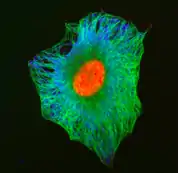Protein filament
In biology, a protein filament is a long chain of protein monomers, such as those found in hair, muscle, or in flagella.[1] Protein filaments form together to make the cytoskeleton of the cell. They are often bundled together to provide support, strength, and rigidity to the cell. When the filaments are packed up together, they are able to form three different cellular parts. The three major classes of protein filaments that make up the cytoskeleton are actin filaments, microtubules and intermediate filaments.

Cellular Types
Microfilaments
Compared to the other parts of the cytoskeletons, the microfilaments contain the thinnest filaments, with a diameter of approximately 7nm. Microfilaments are part of the cytoskeleton that are composed of protein called actin. Microfilaments can either occur in the monomeric G-actin or filamentous F-actin.[2]
Microtubules

Microtubules are the largest type of filament, with a diameter of 25 nm wide, in the cytoskeleton. [[3]] A single microtubule consists of 13 linear microfilaments. Unlike microfilaments, microtubules are composed of a protein called tubulin. The tubulin consists of dimers, named either "αβ-tubulin" or "tubulin dimers", which polymerize to form the microtubules.[3]

Intermediate Filaments
Intermediate filaments are part of the cytoskeleton structure found in most eukaryotic cells. Intermediate filaments contain an average diameter of 10 nm, which is small than that of microtubules, but larger than that of microfilaments.[4]
References
- Speer B, Waggoner B (13 August 1995). "Filament". UCMP Glossary: Cell biology. Berkeley, CA: Museum of Paleontology, University of California. Retrieved November 2, 2011.
- Hohmann T, Dehghani F (April 2019). "The Cytoskeleton-A Complex Interacting Meshwork". Cells. 8 (4): 362. doi:10.3390/cells8040362. PMC 6523135. PMID 31003495.
- Goodson HV, Jonasson EM (June 2018). "Microtubules and Microtubule-Associated Proteins". Cold Spring Harbor Perspectives in Biology. 10 (6): a022608. doi:10.1101/cshperspect.a022608. PMC 5983186. PMID 29858272.
- Herrmann H, Aebi U (November 2016). "Intermediate Filaments: Structure and Assembly". Cold Spring Harbor Perspectives in Biology. 8 (11): a018242. doi:10.1101/cshperspect.a018242. PMC 5088526. PMID 27803112.